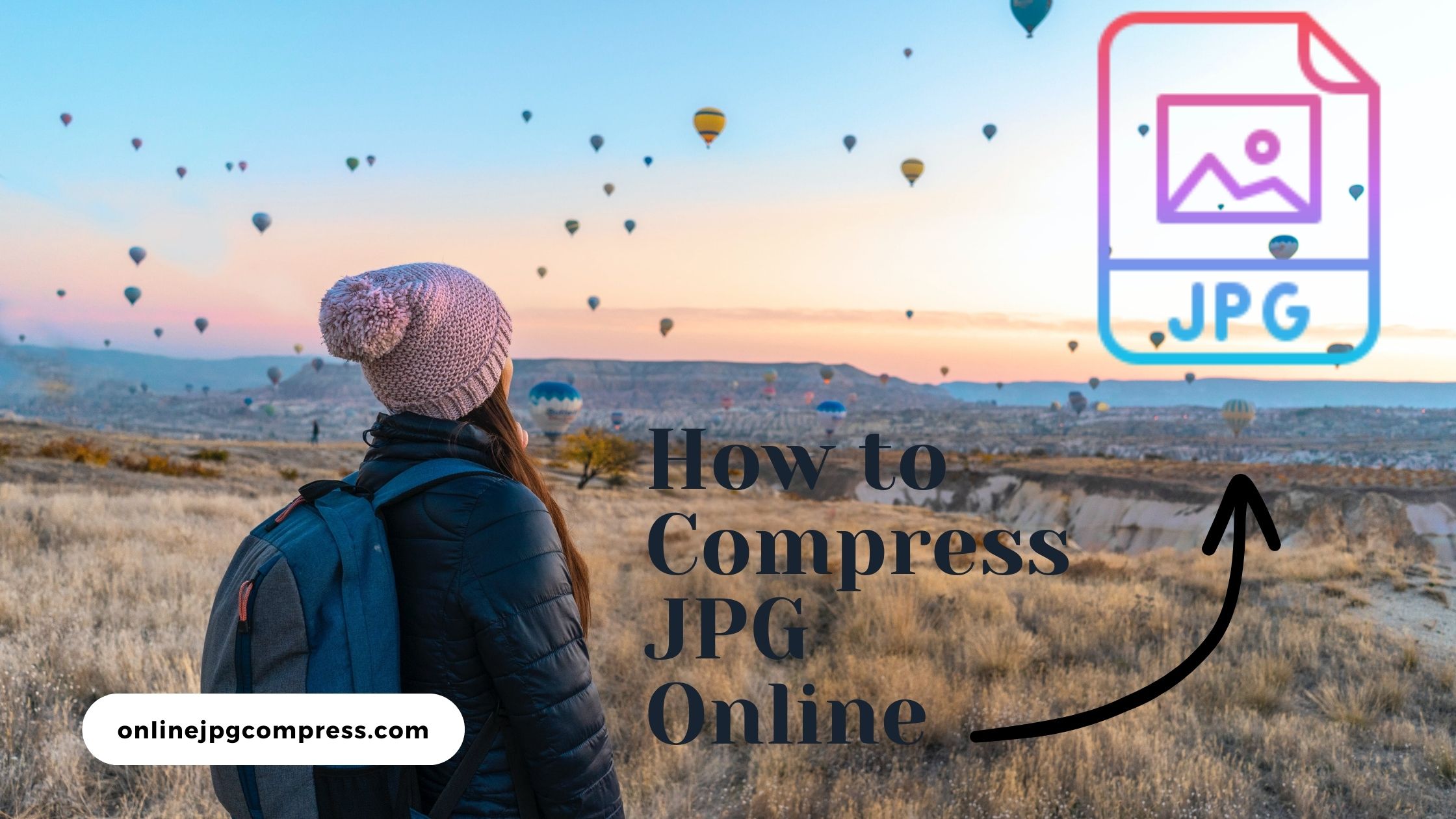Introduction
In the ever-evolving landscape of digital media, the efficient management of image files has become a paramount concern. Among the myriad file formats, the JPEG (or JPG) stands out as a widely embraced format for its balance between image quality and file size. However, with the escalating volume of digital imagery, the need to Compress JPG Online files has become imperative.
This comprehensive guide navigates the intricate realm of compress JPG Online files online, a practice pivotal for individuals and businesses alike.
As we embark on this exploration, it is crucial to recognize the challenges posed by large file sizes, extending beyond mere storage constraints.
In an era where website performance and user experience are non-negotiable aspects of digital presence, the significance of optimizing JPG files becomes increasingly clear.
As we delve into the nuances of online JPG compress, we aim to demystify the process, making it accessible to professionals, hobbyists, and anyone seeking a more streamlined digital workflow.
Through this guide, we unravel the intricacies of choosing the right compression tools, offer a step-by-step walkthrough of the online compression process, and delve into the myriad benefits that compressed JPG files bring to the forefront.
Join us on this journey through the pixels and bytes, as we explore the transformative impact of compress JPG online files, unlocking a world of optimized storage, faster transfers, and a heightened digital experience.
Read this – Compress JPG Mastery: Streamlining Digital Workflows

Why Compress JPG Online Files?
In the realm of digital imagery, the significance of compress JPG online files transcends mere technicality; it addresses fundamental challenges posed by the burgeoning volume of visual content.
Large JPG file sizes not only consume substantial storage space but also present hurdles in managing and transferring these files efficiently.
The Impact of Large File Sizes
As technology advances and the quality of digital cameras improves, the size of individual image files has grown exponentially.
High-resolution images, while capturing intricate details, often come at the cost of larger file sizes.
This poses a dual challenge – firstly, the sheer volume of these files strains available storage capacity, and secondly, the transfer of such hefty files becomes a time-consuming endeavor.
Balancing Act: Quality vs. Size
Compress JPG online files becomes a strategic balancing act between maintaining visual integrity and minimizing file size.
The goal is to achieve optimal compression levels where the reduction in file size is substantial enough to enhance efficiency but without compromising the essence and quality of the image.
The Need for Speed: Improved File Transfers
One of the immediate benefits of compress JPG online files is the acceleration of file transfers.
Whether uploading images to a cloud server, sharing them via email, or integrating them into a website, the reduced file size ensures swifter uploads and downloads.
This not only saves time but also contributes to a more seamless digital experience, particularly in an era where immediacy is paramount.
Enhancing Website Performance and User Experience
For website owners, the impact of compress JPG online files on performance is noteworthy.
Reduced file sizes translate to faster loading times, a crucial factor in retaining the attention of online visitors.
This optimization contributes not only to a smoother user experience but also positively influences search engine rankings, as site speed is a recognized factor in search algorithms.
Beyond Storage: Bandwidth Savings and Mobile Optimization
Compressed JPG files bring additional advantages.
They contribute to significant bandwidth savings, particularly pertinent for users with limited data plans or for website administrators mindful of bandwidth costs.
Moreover, in the era of mobile dominance, where a substantial portion of digital content is consumed on smartphones and tablets.
Compressed images ensure faster loading times, catering to the preferences of mobile users.
In essence, the imperative to compress JPG files lies in its transformative impact on storage efficiency, file transfer speed, website performance, and overall user experience.
As we navigate the complexities of digital media, the practice of compressing JPG files emerges as a fundamental strategy to enhance digital workflows and embrace a more streamlined and efficient approach to managing visual content.
Choosing the Right Online Compression Tools
In the expansive landscape of online compression tools, choosing the right platform is pivotal for achieving optimal results.
Several user-friendly and efficient tools have emerged, each with its unique features and functionalities.
Let’s explore the considerations and popular options when it comes to selecting the right online compression tool for JPG files.
Introducing Popular Online Platforms
TinyPNG:
Key Features: Renowned for its simplicity and effectiveness, TinyPNG employs advanced compression techniques to reduce file sizes without compromising image quality.
The platform supports both JPG and PNG formats, making it a versatile choice.
Compressor.io:
Key Features: Compressor.io excels in its ability to compress various image formats, including JPG.
It offers users the choice between lossy and lossless compression, providing flexibility based on specific preferences and requirements.
JPEG-Optimizer:
Key Features: As the name suggests, JPEG-Optimizer specializes in optimizing JPG files.
Users can customize compression levels and view a side-by-side comparison of the original and compressed images, allowing for a nuanced approach to file optimization.
Evaluating Key Features
User Interface:
An intuitive and user-friendly interface is paramount, especially for individuals with varying levels of technical expertise.
Look for platforms that simplify the compression process through clear and accessible interfaces.
Customization Options:
The ability to customize compression settings is crucial for tailoring the process to specific needs.
Look for tools that offer options such as adjusting compression levels, resizing images, and choosing between lossy and lossless compression.
Security Considerations:
As image files often contain sensitive information, prioritizing platforms with robust security measures is essential.
Ensure that the chosen tool guarantees the privacy and protection of uploaded images.
Accessibility and Advantages of Online Platforms
Ease of Access:
Online compression tools eliminate the need for intricate software installations.
Users can access these platforms through web browsers, facilitating a hassle-free compression experience.
Advantages of Online Tools:
Online platforms are particularly advantageous for users seeking convenience and quick results.
They offer a plug-and-play approach, reducing the learning curve associated with more complex software.
Step-by-Step Guide to Online Compression
Navigating the realm of online JPG compression involves a series of strategic steps, ensuring that the process is not only efficient but also tailored to the specific needs of the user.
In this step-by-step guide, we’ll walk through the intricacies of compressing JPG files using online platforms, demystifying the process for users of all levels of expertise.
I. Selecting the Right Tool
The journey begins with the crucial task of selecting an online compression tool that aligns with the user’s requirements.
As discussed earlier, platforms like TinyPNG, Compressor.io, and JPEG-Optimizer offer unique features.
Allowing users to choose based on their preferences, whether it’s simplicity, versatility, or specialized optimization for JPG files.
II. Uploading JPG Files
Once the tool is selected, the next step involves uploading the JPG files for compression.
Most online platforms facilitate this process through a straightforward interface.
Users typically navigate to the chosen platform’s website, locate the upload option, and select the JPG files they wish to compress.
This intuitive process ensures accessibility for users with varying levels of technical proficiency.
III. Customization Options
After uploading the files, users are often presented with a range of customization options to tailor the compression process.
These options may include:
A. Compression Levels:
Users can choose the degree of compression, balancing file size reduction with image quality.
This allows for flexibility based on the specific requirements of the project.
B. Resizing Images:
Some platforms offer the option to resize images during the compression process.
This is particularly useful when specific dimensions are needed for a website, presentation, or other digital platforms.
C. Format Adjustments:
Depending on the tool, users may have the option to adjust the format of the compressed files.
This flexibility ensures compatibility with various digital platforms and applications.
IV. Adjusting Compression Levels
Fine-tuning the compression levels is a critical aspect of the process.
Users can experiment with different compression settings to find the optimal balance between file size reduction and image quality.
Most platforms provide visual previews, allowing users to assess the impact of compression before finalizing the process.
V. Additional Features (e.g., Resizing)
Exploring additional features like resizing during the compression process adds another layer of control.
Users can specify dimensions, ensuring that the compressed images meet specific size requirements without sacrificing visual integrity.
VI. Emphasis on User-Friendly Interfaces
Throughout these steps, the emphasis on user-friendly interfaces becomes evident.
Online compression tools prioritize accessibility, ensuring that users can navigate the customization options with ease.
Visual cues, tooltips, and intuitive design contribute to a seamless experience for individuals with varying levels of technical expertise.
VII. Finalizing the Compression Process
Once customization is complete and users are satisfied with the compression settings, the final step involves initiating the compression process.
Users typically trigger this by clicking a “Compress” or “Optimize” button.
The platform then processes the selected JPG files according to the specified settings, generating compressed versions ready for download.
VIII. Downloading Compressed JPG Files
The last step in this journey involves downloading the compressed JPG files to the user’s device.
Most platforms provide a straightforward download option, allowing users to access the optimized files with a single click.
In conclusion, the step-by-step guide to online JPG compression is characterized by its user-centric approach.
From selecting the right tool and uploading files to customizing compression settings and downloading the optimized results, each step is designed to be intuitive and accessible.
Whether a novice or an experienced user, individuals can efficiently navigate this process, unlocking the benefits of compressed JPG files for a more streamlined and optimized digital experience.

Benefits of Compressing JPG Files
Compressing JPG files isn’t just a technical maneuver; it’s a strategic approach that yields a multitude of benefits, ranging from storage efficiency to enhanced digital experiences.
Let’s delve into the advantages that arise from the practice of compressing JPG files:
Optimized Storage Efficiency
One of the primary benefits of compressing JPG files is the significant reduction in storage space they occupy.
High-resolution images captured by modern cameras can be sizable, placing a strain on available storage capacity.
Compression mitigates this challenge, allowing users to store more images without the need for additional storage solutions.
This becomes especially pertinent for photographers, graphic designers, and anyone managing a vast library of visual content.
Accelerated File Transfers
Compressed JPG files contribute to faster and more efficient file transfers.
Whether uploading images to cloud storage, sharing them via email, or integrating them into a website, reduced file sizes translate to quicker uploads and downloads.
This acceleration not only saves time but also streamlines digital workflows, contributing to a more seamless and responsive user experience.
Improved Website Performance
For website owners, the impact of compressed JPG files on overall performance is substantial.
Large image files can impede website loading times, leading to user frustration and potential bounce rates.
Compressed images, being smaller in size, load faster, resulting in a smoother user experience.
In the competitive landscape of online presence, where seconds matter, optimized website performance can make a significant difference in retaining visitors and enhancing user engagement.
Bandwidth Savings and Mobile Optimization
Compressed JPG files bring forth additional advantages in terms of bandwidth efficiency.
Users with limited data plans or those managing websites with bandwidth constraints benefit significantly from the reduced data transfer requirements of compressed images.
Moreover, in an era dominated by mobile devices, compressed files ensure faster loading times for users accessing content on smartphones and tablets.
This mobile optimization aligns with evolving user preferences and contributes to a more responsive and accessible digital environment.
Preservation of Image Quality
Contrary to common misconceptions, effective JPG compression can be achieved without sacrificing noticeable image quality.
Striking the right balance between compression levels and visual integrity ensures that compressed images maintain a high standard of quality.
This becomes crucial, especially in professional contexts where image fidelity is paramount.
In essence, the benefits of compressing JPG files extend far beyond the technical realm.
They empower users to optimize storage, accelerate digital processes, and elevate the overall quality of digital content.
Whether for personal photo collections, professional portfolios, or website management, embracing JPG compression emerges as a fundamental strategy in navigating the evolving landscape of digital media, enhancing both efficiency and user experience.
Best Practices for Optimal Compression
Achieving optimal JPG compression involves a nuanced approach that balances file size reduction with the preservation of image quality.
As users navigate the compression process, adopting best practices ensures that the outcome aligns with their specific needs and preferences.
Here are key best practices for optimal JPG compression:
Finding the Right Balance
The heart of optimal compression lies in finding the perfect balance between file size reduction and image quality preservation.
Users should experiment with different compression levels offered by online tools to strike the ideal equilibrium.
This involves assessing the visual impact of compression and ensuring that the resulting images meet the intended standards.
Understanding Lossy vs. Lossless Compress JPG
Comprehending the difference between lossy and lossless compression is fundamental.
Lossy compression sacrifices some degree of image data to achieve higher levels of compression, often resulting in smaller file sizes.
Lossless compression, on the other hand, retains all original image data, ensuring no loss in quality.
Choosing between these methods depends on the user’s specific requirements and the acceptable level of quality compromise.
Resizing Images Before Compress JPG Online
For users seeking optimal control over the compression process, resizing images before compression is a strategic best practice.
This step allows users to set specific dimensions, ensuring that the compressed images align with predefined size requirements.
Resizing also offers an additional layer of customization and control, particularly useful in scenarios where standardized image dimensions are crucial.
Emphasizing User-Friendly Interfaces
Optimal compression experiences are characterized by user-friendly interfaces.
Online compression tools that prioritize intuitive design, visual previews, and straightforward customization options enhance the user experience.
This approach ensures that individuals with varying levels of technical expertise can navigate the compression process effortlessly.
Documenting Compress JPG Online Settings
To streamline future compression endeavors, users are encouraged to document their preferred compression settings.
This practice helps maintain consistency across projects and simplifies the replication of compression parameters for similar types of images.
Documentation becomes particularly valuable in professional contexts where maintaining a standardized visual aesthetic is essential.
By incorporating these best practices, users can harness the full potential of JPG compression, achieving optimal results tailored to their specific needs.
Whether managing personal photo collections or optimizing images for professional use.
A strategic and informed approach to compression ensures a seamless blend of efficiency and image quality.
Real-world Applications and Case Studies of Online Compress JPG
Real-world applications and case studies vividly illustrate the tangible impact of optimal JPG compression across various domains. These success stories exemplify how individuals and businesses have harnessed the benefits of compressed images to enhance their digital experiences.
Success Stories in Photography:
Professional photographers, facing the challenge of managing vast archives of high-resolution images, have embraced JPG compression to optimize storage without compromising quality.
This practice enables them to efficiently organize, transfer, and showcase their portfolios, streamlining both workflow and client interactions.
E-Commerce Optimization:
In the realm of e-commerce, where visuals play a pivotal role, compressing product images is a common strategy.
By reducing file sizes without sacrificing quality, online retailers can ensure fast-loading product pages, creating a seamless shopping experience.
Case studies reveal significant improvements in conversion rates and customer satisfaction.
Web Development and Design:
Web developers and designers leverage JPG compression to enhance website performance.
In case studies, businesses have reported substantial decreases in page load times, resulting in improved search engine rankings and a boost in user engagement.
Compressed images contribute to a visually appealing and responsive online presence.
Bandwidth Savings for Online Platforms:
Online platforms and social media networks incorporate JPG compression to optimize bandwidth usage.
Case studies demonstrate how platforms with millions of users have significantly reduced data transfer requirements, resulting in cost savings and improved service reliability, especially in regions with limited connectivity.
Mobile App Optimization:
Mobile app developers integrate JPG compression to streamline app performance.
Case studies in the mobile industry reveal reduced app download sizes, faster installation times, and enhanced responsiveness, leading to improved user retention and positive reviews.
These real-world applications underscore the versatility and effectiveness of JPG compression in addressing the diverse needs of different industries.
As businesses and individuals continue to navigate the digital landscape.
The success stories and case studies in JPG compression serve as valuable insights, showcasing the transformative power of optimized image management.

Conclusion
In conclusion, the practice of compressing JPG files emerges as a transformative and indispensable strategy in the dynamic realm of digital media.
From photographers seeking to streamline vast archives to e-commerce platforms optimizing user experiences.
The benefits of compression are far-reaching. Real-world case studies underscore its effectiveness, revealing tangible improvements in storage efficiency, website performance, and overall user satisfaction.
As we navigate the ever-evolving landscape of visual content, the strategic balance between file size reduction and image quality preservation becomes paramount.
By adhering to best practices and leveraging user-friendly online tools.
Individuals and businesses can harness the full potential of JPG compression, unlocking a future where optimized digital workflows and enhanced experiences seamlessly coexist.
Embracing this approach not only addresses the challenges of the present but also positions us for a more efficient and visually compelling digital future.

2 thoughts on “Compress JPG Online: Streamlining Digital Imagery”